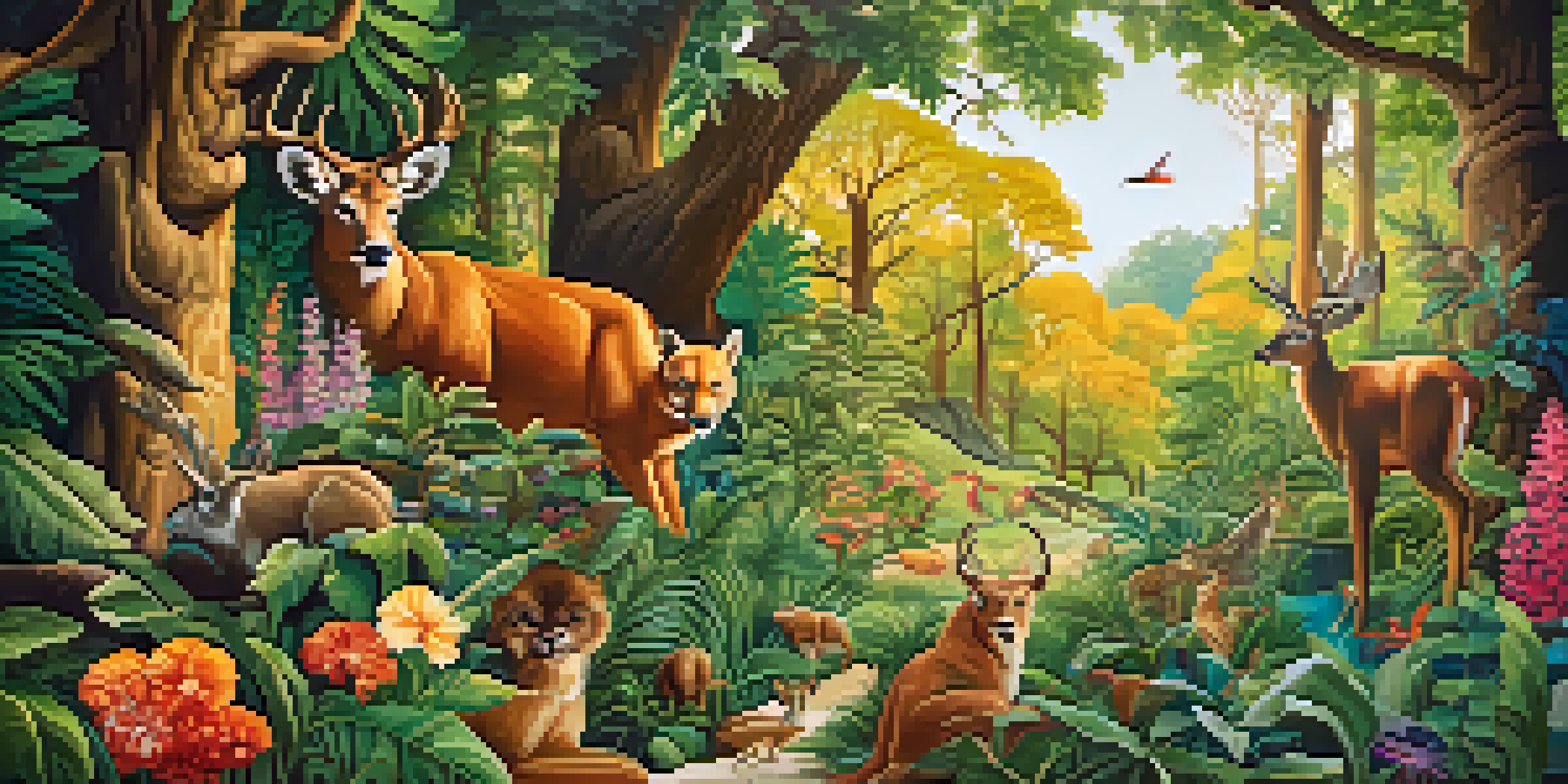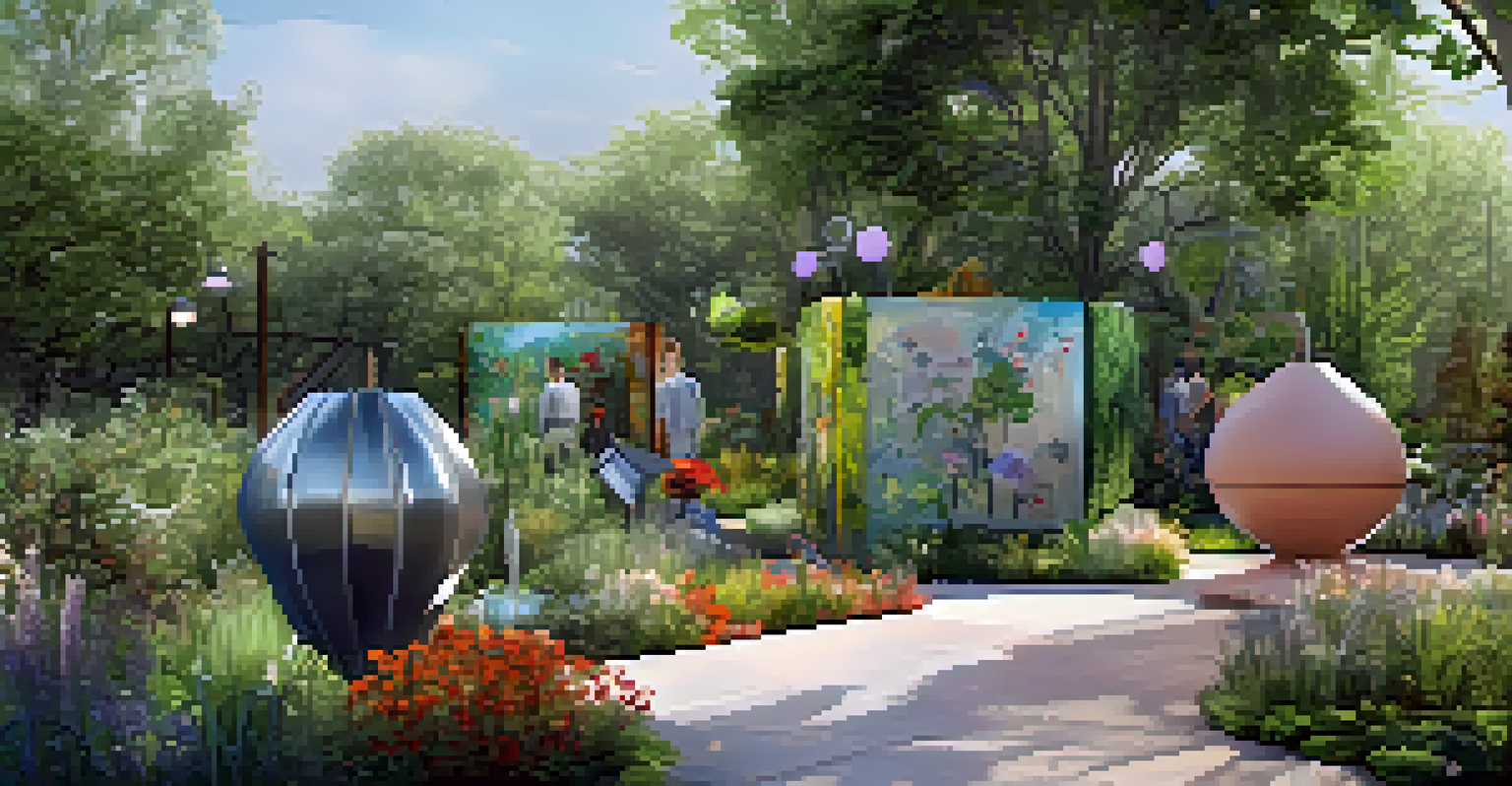The Intersection of Art and Ecology: A Sustainable Future

Understanding Art's Role in Environmental Awareness
Art has long been a powerful medium for expressing ideas and emotions, but its role in raising environmental awareness is particularly significant. Through various forms of artistic expression, creators can shed light on ecological issues that might otherwise go unnoticed. For instance, a striking mural depicting the effects of climate change can provoke thought and inspire action among viewers.
Art is not a mirror to hold up to society, but a hammer with which to shape it.
Visual arts, literature, and performance all serve as platforms to engage audiences with critical ecological themes. Artists often use their work to challenge societal norms, prompting individuals to reconsider their relationship with nature. This emotional connection can be a catalyst for change, encouraging people to adopt more sustainable practices in their daily lives.
Ultimately, art not only reflects the state of our environment but also has the potential to inspire collective action toward a more sustainable future. By fostering conversations around environmental issues, artists can mobilize communities to advocate for ecological preservation and restoration.
How Ecology Influences Artistic Expression
The natural world profoundly influences artists, shaping their perspectives and creative processes. Many artists find inspiration in the intricate beauty of ecosystems, using their work to celebrate nature's diversity. For example, a landscape painter might capture the vibrant colors of a sunset over a forest, evoking a sense of wonder and appreciation for the environment.

Moreover, ecological themes often lead artists to explore their own environmental footprints. This self-reflection can manifest in art that critiques consumerism and promotes sustainable living. By integrating eco-friendly materials and practices into their work, artists can embody the very principles they advocate for, reinforcing the message of sustainability.
Art as a Catalyst for Change
Art serves as a powerful medium to raise awareness about environmental issues and inspire action among communities.
This reciprocal relationship between art and ecology highlights the importance of preserving natural spaces not just for their own sake, but as sources of inspiration for future creative endeavors. When artists engage with their surroundings, they remind us of the beauty worth protecting.
The Rise of Eco-Art and Its Impact
Eco-art is a burgeoning movement that explicitly focuses on environmental issues through artistic expression. Artists involved in this genre often create works that directly address ecological concerns, such as pollution, habitat destruction, and climate change. This form of art not only raises awareness but also encourages viewers to engage in meaningful dialogue about the state of our planet.
The best artist has no conception that a marble block does not contain within itself the statue; it is the artist who sets it free.
Projects like large-scale installations or community-based art initiatives can have a profound impact, transforming public spaces into platforms for ecological education. For instance, a community garden designed by artists can serve as both a work of art and a sustainable food source, bridging the gap between aesthetics and functionality.
By fostering a deeper understanding of environmental issues, eco-art can inspire individuals to take personal responsibility for their ecological impact. It acts as a reminder of the interconnectedness of all living things, urging us to reconsider our roles within the larger ecological tapestry.
Art as a Tool for Climate Activism
Art has become an essential tool in the fight against climate change, serving as a medium for activism and advocacy. Artists use their platforms to amplify urgent messages about environmental degradation and the need for immediate action. From powerful documentaries to eye-catching social media campaigns, art can mobilize audiences and inspire them to join the cause.
For instance, public art installations that depict the effects of rising sea levels can evoke a visceral response, prompting viewers to consider the realities of climate change. Such works can serve as a rallying cry, encouraging individuals to participate in protests, sign petitions, or support eco-friendly policies.
Eco-Art Promotes Sustainability
The eco-art movement directly addresses ecological concerns, transforming public spaces into platforms for environmental education.
Through creative expression, artists can communicate complex scientific concepts in a way that resonates emotionally with the public. This ability to connect on a personal level can be a game-changer in the fight for climate justice, as it encourages collective action toward a sustainable future.
Collaborative Projects Between Artists and Ecologists
Collaborations between artists and ecologists often yield innovative projects that bridge the gap between creativity and science. These partnerships can lead to the development of artworks that not only inform but also engage communities in ecological conservation efforts. For example, an artist might work with scientists to create an interactive exhibit that educates visitors about local biodiversity.
Such projects can enhance public understanding of complex environmental issues by combining scientific research with artistic interpretation. They provide a unique opportunity for audiences to explore ecological concepts in a hands-on way, making the information more accessible and relatable.
These collaborations also foster a sense of shared responsibility for the environment. When artists and ecologists unite, they create a powerful synergy that can inspire communities to take action and advocate for sustainable practices.
The Future of Art and Ecology: A Sustainable Vision
Looking ahead, the intersection of art and ecology holds immense potential for fostering a sustainable future. As climate change and environmental degradation become increasingly pressing issues, artists will play a crucial role in shaping public perception and inspiring action. The integration of ecological themes into artistic practices can cultivate a greater sense of environmental stewardship.
Moreover, as technology evolves, artists have new tools at their disposal to engage audiences in innovative ways. Virtual reality experiences, for example, can immerse viewers in threatened ecosystems, allowing them to experience the beauty of nature while understanding the urgency of its preservation.
Community Engagement Through Art
Artistic initiatives foster collective action and empower individuals to take ownership of their environmental impact.
By continuing to explore the relationship between art and ecology, we can envision a future where creativity and sustainability go hand in hand. Together, they can inspire a culture that values and protects our planet, ensuring a thriving world for generations to come.
Engaging Communities Through Artistic Initiatives
Community engagement is a vital component of merging art and ecology, as it encourages collective action and environmental stewardship. Initiatives such as community art projects or eco-themed workshops can bring people together to create and learn about sustainability. These activities not only foster a sense of belonging but also empower individuals to take ownership of their environmental impact.
For example, a local mural project that focuses on a community's natural resources can spark conversations about conservation and inspire residents to take steps to protect their environment. When art becomes a communal effort, it cultivates a shared vision for a sustainable future.

Furthermore, these initiatives can nurture creativity within communities, helping individuals express their connection to the environment. By harnessing the power of artistic expression, we can inspire deeper engagement with ecological issues and create lasting change.